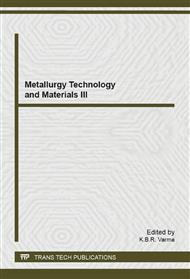p.194
p.198
p.202
p.206
p.213
p.218
p.222
p.226
p.230
Numerical Simulations of Macrosegregation: A Comparison between Orthogonal Grids and Non-Orthogonal Grids
Abstract:
Macrosegregation predictions have been performed for the alloy solidification in regular and irregular geometries. The continuum model is used to describe the mass, momentum, species, and energy transportation. Based on the same conservation equations, different discretization forms are derived for the orthogonal grids and non-orthogonal grids. Comparisons are made between the results with orthogonal grids and non-orthogonal grids for different cases. Firstly, simulations are conducted for the Pb-48%Sn alloy solidified in a rectangle cavity, i.e., the H-H benchmark. Then, simulations are applied to a 53t steel ingot. Prediction results are compared with concentration measurements along different transverse sections. Although both prediction results are in good agreements with the measurements or results in references, some differences can be observed due to the different boundary fitness. It is advised to adopt the non-orthogonal grids in macrosegregation simulations instead of the orthogonal grids for complex computation domains.
Info:
Periodical:
Pages:
213-217
Citation:
Online since:
June 2014
Authors:
Keywords:
Price:
Сopyright:
© 2014 Trans Tech Publications Ltd. All Rights Reserved
Share:
Citation:


